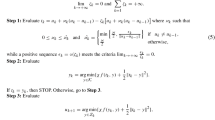Abstract
In this paper we consider the question of solving equilibrium problems—formulated as complementarity problems and, more generally, mathematical programs with equilibrium constraints (MPECs)—as nonlinear programs, using an interior-point approach. These problems pose theoretical difficulties for nonlinear solvers, including interior-point methods. We examine the use of penalty methods to get around these difficulties and provide substantial numerical results. We go on to show that penalty methods can resolve some problems that interior-point algorithms encounter in general.
Similar content being viewed by others
References
M. Anitescu, “Nonlinear programs with unbounded lagrange multiplier sets,” Technical Report ANL/MCS-P793-0200.
H.Y. Benson, D.F. Shanno, and R.J. Vanderbei, “Interior point methods for nonconvex nonlinear programming: filter methods and merit functions,” Computational Optimization and Applications, vol. 23, pp. 257–272, 2002.
H.Y. Benson, D.F. Shanno, and R.J. Vanderbei, “Interior point methods for nonconvex nonlinear programming: Jamming and comparative numerical testing,” Math. Programming, vol. 99, no. 1, pp. 35–48, 2004.
R.H. Byrd, M.E. Hribar, and J. Nocedal, “An interior point algorithm for large scale nonlinear programming,” SIAM Journal on Optimization, vol. 9, no. 4, pp. 877–900, 1999.
M.C. Ferris, S.P. Dirkse, and A. Meeraus, “Mathematical programs with equilibrium constraints: Automatic reformulation and solution via constrained optimization,” in Frontiers in Applied General Equilibrium Modeling, T.J. Kehoe, T.N. Srinivasan, and J.Whalley (Eds.), Cambridge University Press, 2005, pp. 67–95.
M.C. Ferris and C. Kanzow, “Complementarity and related problems: A survey,” in Handbook of Applied Optimization, P.M. Pardalos and M.G.C. Resende (Eds.), Oxford University Press, New York, 2002, pp. 514–530.
M.C. Ferris and J.-S. Pang, “Engineering and economics applications of complementarity problems,” SIAM Review, vol. 39, pp. 669–713, 1997.
R. Fletcher and S. Leyffer, “Numerical experience with solving MPECs as NLPs,” Optimization Methods and Software, vol. 19, no. 1, pp. 15–40, 2004.
R. Fletcher, S. Leyffer, and P. L. Toint, “On the global convergence of a filter-SQP algorithm,” SIAM Journal on Optimization, vol. 13, no. 1, pp. 44–59, 2002.
P.E. Gill, W. Murray, and M.A. Saunders, “snopt: An SQP algorithm for large-scale constrained optimization,” SIAM Journal on Optimization, vol. 12, pp. 979–1006, 2002.
W. Hock and D. Schittkowski, “Test examples for nonlinear programming codes,” Lecture Notes in Economics and Mathematical Systems 187, Springer Verlag, Heidelberg, 1981.
J. Huang and J.-S. Pang, “Option pricing and linear complementarity,” Journal of Computational Finance, vol. 2, no. 3, 1998.
S. Leyffer, MacMPEC Test Suite. http://www-unix.mcs.anl.gov/∼leyffer/MacMPEC
H. Scheel and S. Scholtes, “Mathematical program with complementarity constraints: Stationarity, optimality and sensitivity,” Mathematics of Operations Research, vol. 25, pp. 1–22, 2000.
S. Scholtes, “Convergence properties of a regularization scheme for mathematical programs with complementarity constraints,” SIAM Journal on Optimization, vol. 11, pp. 918–936, 2001.
A. Sen and D.F. Shanno, “Computing nash equilibria for stochastic games” (working paper).
E.M. Simantiraki and D.F. Shanno, “An infeasible interior-point algorithm for solving mixed complementarity problems,” in Complementarity and Variational Problems, State of the Art, Complementarity and Variational Problems, State of the Art, M.C. Ferris and J.S. Pang (Eds.), SIAM, Philadelphia, 1997, pp. 386–404.
R.J. Vanderbei and D.F. Shanno, “An Interior-point algorithm for nonconvex nonlinear programming,” Computational Optimization and Applications, vol. 13, pp. 231–252, 1999.
A. Waechter and L.T. Biegler, “On the implementation of a primal-dual interior point filter line search algorithm for large-scale nonlinear programming,” Technical Report RC 23149, IBM T. J. Watson Research Center, Yorktown Heights, NY, March 2004.
Author information
Authors and Affiliations
Corresponding author
Additional information
An erratum to this article is available at http://dx.doi.org/10.1007/s10589-006-9594-3.
Rights and permissions
About this article
Cite this article
Benson, H.Y., Sen, A., Shanno, D.F. et al. Interior-Point Algorithms, Penalty Methods and Equilibrium Problems. Comput Optim Applic 34, 155–182 (2006). https://doi.org/10.1007/s10589-005-3908-8
Received:
Revised:
Accepted:
Published:
Issue Date:
DOI: https://doi.org/10.1007/s10589-005-3908-8




